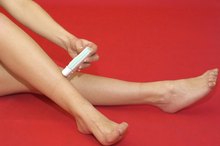What does fact checked mean?
At Healthfully, we strive to deliver objective content that is accurate and up-to-date. Our team periodically reviews articles in order to ensure content quality. The sources cited below consist of evidence from peer-reviewed journals, prominent medical organizations, academic associations, and government data.
- Mayo Clinic: Peripheral Vascular Disease Symptoms
- Mayo Clinic: Peripheral Artery Disease
- Family Doctor: Hair Loss and Its Causes
The information contained on this site is for informational purposes only, and should not be used as a substitute for the advice of a professional health care provider. Please check with the appropriate physician regarding health questions and concerns. Although we strive to deliver accurate and up-to-date information, no guarantee to that effect is made.
Why Is the Hair on My Legs Falling Out?
Partial or complete hair loss anywhere on the body could be symptomatic of a serious medical condition, or it may warrant nothing more than a change of wardrobe for a week or two. If you are experiencing sudden hair loss, it is a good idea to speak with your doctor.
Circulation Problems
Significant hair loss of the extremities can be a symptom of peripheral vascular disease--a progressive narrowing of the arteries which, left untreated, can lead to gangrene, ruptured abdominal and thoracic aortic aneurysms, transient ischemic attacks (TIA), also known as "mini-strokes" or even a stroke or heart attack 12.cause:
- Significant hair loss of the extremities can be a symptom of peripheral vascular disease--a progressive narrowing of the arteries which
- left untreated
- can lead to gangrene
- ruptured abdominal
- thoracic aortic aneurysms
- transient ischemic attacks (TIA)
- also known as "mini-strokes" or even a stroke or heart attack 12
Other symptoms of peripheral vascular disease include a darkening or bluish tinge to the arms, legs or feet, skin lesions that will not heal, a limp when walking and pain in the toes or feet while resting 12. If you are experiencing any of these symptoms, see a doctor immediately for evaluation.
Hormone Imbalance
Why Am I Losing Hair on My Ankles?
Learn More
If you are suddenly losing hair anywhere on your body--including your legs--it could be due to an imbalance of hormones caused by a thyroid disorder, menopause, pregnancy, depression or extreme stress. Ask your doctor to perform a routine series of blood tests to determine the levels of hormone in your body. Depending on the outcome, he may suggest a lifestyle change, yoga or another relaxation technique, a change to your diet, synthetic thyroid hormones, estrogen replacement or other hormone-related therapy.
- If you are suddenly losing hair anywhere on your body--including your legs--it could be due to an imbalance of hormones caused by a thyroid disorder, menopause, pregnancy, depression or extreme stress.
- Depending on the outcome, he may suggest a lifestyle change, yoga or another relaxation technique, a change to your diet, synthetic thyroid hormones, estrogen replacement or other hormone-related therapy.
Dermatitis
Certain types of dermatological conditions caused by bacteria, fungus or yeast can cause hair loss on the legs. When hair follicles become clogged with excess oil, flora or dead skin, hair growth becomes inhibited and may cease altogether. Treatment involves identifying the type of dermatitis and administering a cure to the skin. In some cases, the condition may persist for weeks, months or even years and may be resistant to medication. It is possible for the affected hair follicles to be too damaged to ever regrow hair.
- Certain types of dermatological conditions caused by bacteria, fungus or yeast can cause hair loss on the legs.
Benign Causes
What Causes Pimples on Legs?
Learn More
Leg hair loss can be caused by a number of relatively benign conditions, including friction from pants, socks that are too tight, boots that are rubbing against a part of the leg or similar issues. If you think your clothing may be causing your hair loss, try adjusting it for several days to see if your leg hair returns. If not, you may wish to see a doctor to investigate the cause.
Food Allergies and Autoimmune Disorders
Hair loss, including on the leg, can be caused by an allergic reaction to food or an overactive autoimmune response to toxins such as pesticides, heavy metals, chemicals or food additives. Working with an allergist, nutritionist, dietitian or immunologist, you may be able to determine what is causing the condition through an elimination diet or by paying close attention to your body's reaction to your daily environment. Once the trigger is found, you may be able to heal your skin and regrow your leg hair by avoiding the allergen.
Related Articles
References
- Mayo Clinic: Peripheral Vascular Disease Symptoms
- Mayo Clinic: Peripheral Artery Disease
- American Diabetes Association: Symptoms
- Family Doctor: Hair Loss and Its Causes
- Phillips TG, Slomiany WP, Allison R. Hair Loss: Common Causes and Treatment. Am Fam Physician. 2017;96(6):371-378.
- Watras MM, Patel JP, Arya R. Traditional anticoagulants and hair loss: a role for direct oral anticoagulants? A review of the literature. Drugs Real World Outcomes. 2016;3(1):1-6. doi:10.1007/s40801-015-0056-z
- Urysiak-czubatka I, Kmieć ML, Broniarczyk-dyła G. Assessment of the usefulness of dihydrotestosterone in the diagnostics of patients with androgenetic alopecia. Postepy Dermatol Alergol. 2014;31(4):207-15. doi:10.5114/pdia.2014.40925
- Vincent M, Yogiraj K. A descriptive study of alopecia patterns and their relation to thyroid dysfunction. Int J Trichology. 2013;5(1):57-60. doi:10.4103/0974-7753.114701
- Peters EMJ, Müller Y, Snaga W, et al. Hair and stress: A pilot study of hair and cytokine balance alteration in healthy young women under major exam stress. PLoS ONE. 2017;12(4):e0175904. doi:10.1371/journal.pone.0175904
- Pratt CH, King LE, Messenger AG, Christiano AM, Sundberg JP. Alopecia areata. Nat Rev Dis Primers. 2017;3:17011. doi:10.1038/nrdp.2017.11
- American Academy of Dermatology. Alopecia Areata: Overview.









